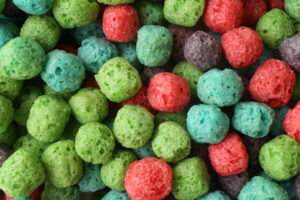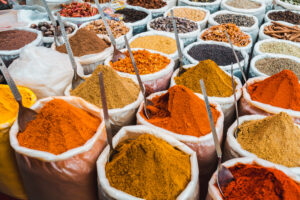If you are familiar with the natural colors world, you probably know there are very few sources of true natural blue shades, at least from living organisms. Blueberries and bluish flowers get their color from anthocyanins that, once extracted out of the cells and in low pH, show their true reddish-violet nature. And birds and butterflies get their blue color not from pigments but from gill-like nanostructures in their feathers and wings.
So how do we get a true natural blue shade that we can use in foods and beverages? In this article, we’ll dive into two different sources of blue pigments and how they complement each other to provide blue shades for a full spectrum of food and beverage applications.
Finding a True Blue
Some photosynthesizing organisms produce pigments that work as antennas to catch portions of the light spectrum that chlorophyll can’t. These pigments are called phycobiliproteins. As their name suggests, they have an important portion comprised of a protein, and another smaller portion that gives them their characteristic color. One of these phycobiliproteins produced by microalgae and cyanobacteria, are the beautiful, true blue phycocyanins(1).
Spirulina: from Ancient Oceans
You probably already know one source of phycocyanins: Spirulina platensis, a cyanobacteria; in the contest of really ancient species, cyanobacteria would likely win the prize. These tiny microscopic creatures have inhabited planet Earth since its early beginnings and are classed as Procaryotic, which among other things means that they lack a nucleus.
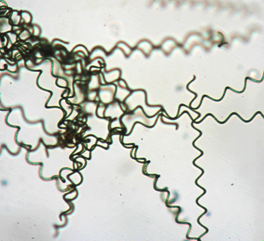
The type of phycocyanins extracted from spirulina, deliver an astonishingly beautiful blue color, that is water soluble, intense and sharp in hue. It resembles Brilliant Blue (FD&C Blue no. 1), and is excellent for neutral pH applications like ice cream, candy coating, frostings and icings, and protein beverage instant mixes.

Gently water extracted at our Sense Colour facility in Avignon, our Everzure™ spirulina is formulated as a color to fulfill all sorts of technological needs. Be it as a liquid format for ease of applicability and dosing, or as a readily dispersible powder, Everzure™ spirulina is crafted to perform in every suitable application.
It’s also formulated as a micronized suspension in oil, under our michroma™ brand, ensuring fabulous blues in fatty applications, like compound coatings, creams, and frostings, minimizing fat-to-fat color bleeding.

Galdieria: Adapt and Conquer
Another group of living organisms that produce phycocyanins to increase their photosynthetic capabilities are found among algae of the division Rhodophyta. One of these, Galdieria sulphuraria, is a genuine jewel in the quest for survival and is currently in the approval process to be added as natural color option in the US and EU.
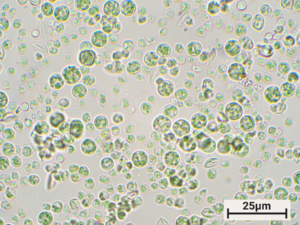
This red (yes, red!) microalga, is what biologists call an extremophile, meaning it is able to survive and thrive in the harshest environments. Its niche ecosystems are acidic hot springs and volcanic calderas, with temperatures above 40ºC and pH levels below 4.0.
When they don’t have enough light, they grow heterotrophically (getting their energy from nutrients, like carbohydrates). When there is enough light available, they photosynthesize their own energy sources with the help of chlorophyll and auxiliary pigments like phycocyanin(3)!
As part of the evolutionary strategies to survive the acidic conditions of their extreme environment, Galdieria produces a type of phycocyanin where the protein-based portion is slightly modified, giving it better acid stability(4) than other phycocyanins – it can withstand a pH as low as 2.8, while phycocyanin from Spirulina normally precipitates at pH 4.0.
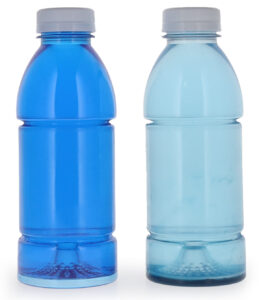
That makes our Everzure™ Galdieria an excellent source of blue for low pH applications like beverages and sugar confections. Gelatin and pectin gummies, acid chews, fruity syrups, frozen novelties and soft beverages of low pH now can get that wondrous hue of blue.

It’s worth celebrating that we will soon have two complementary natural blue color tools available to deliver brilliant results in almost the full spectrum of food and drink categories. And it gets even better…they open the door to vibrant green and luscious purple blends, for an elevated sensory design you envision in your products.
Interested in learning more about galdieria? Sign up for notifications as it moves through the approval process. Or click here to get started with a sample of spirulina.
References
| 1. Dagnino-Leone J, Figueroa CP, Castañeda ML, Youlton AD, Vallejos-Almirall A, Agurto-Muñoz A, et al. Phycobiliproteins: Structural aspects, functional characteristics, and biotechnological perspectives. Comput Struct Biotechnol J [Internet]. 2022;20:1506–27. Available from: http://dx.doi.org/10.1016/j.csbj.2022.02.016
|
| 2. Schirrmeister BE, Gugger M, Donoghue PCJ. Cyanobacteria and the Great Oxidation Event: evidence from genes and fossils. Palaeontology [Internet]. 2015;58(5):769–85. Available from: http://dx.doi.org/10.1111/pala.12178
|
| 3. Curien G, Lyska D, Guglielmino E, Westhoff P, Janetzko J, Tardif M, et al. Mixotrophic growth of the extremophile Galdieria sulphuraria reveals the flexibility of its carbon assimilation metabolism. New Phytol [Internet]. 2021;231(1):326–38. Available from: http://dx.doi.org/10.1111/nph.17359
|
| 4. Wan M, Zhao H, Guo J, Yan L, Zhang D, Bai W, et al. Comparison of C-phycocyanin from extremophilic Galdieria sulphuraria and Spirulina platensis on stability and antioxidant capacity. Algal Res [Internet]. 2021;58(102391):102391. Available from: http://dx.doi.org/10.1016/j.algal.2021.102391 |


